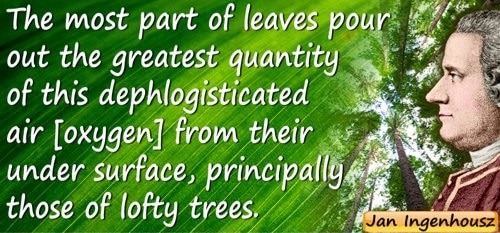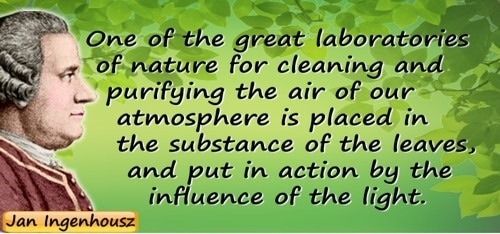Jan Ingenhousz Scientist Biography, Facts & Experiments – Famous Biologists

Ingenhousz, Jan
Dutch Physician (8 Dec 1730- 7 Sep 1799)

Jan Ingenhousz is best known for understanding photosynthesis and demonstrating that light is central to the mechanism by which green plants absorb carbon dioxide and emit oxygen. He also found that plants had cellular respiration, like humans. He was known in his lifetime for successfully inoculating the members of the Habsburg family in Vienna against smallpox in 1768 and later being the Austrian Empress Maria Theresa’s private counselor and personal physician.
Early Life
He has been born in Breda in Staats-Brabant, the Dutch Republic to the patrician Ingen Housz family. At the age of sixteenth, Jan Ingenhousz studied medicine and received his MD in 1753 at the University of Leuven. He has been studying for another two years at Leiden University, where he has lectured, inter alia, by Pieter van Musschenbroek, which leads Jan Ingenhousz to a lifelong belief in energy. He came home to Breda in 1755 and began the general practice of pharmacy.
Work With Smallpox
Jan Ingenhousz was going to study throughout Europe, arriving in England following his father’s death in July 1764, where he wanted to learn the most modern inoculation techniques. He made many valuable contacts in London quickly and became a master inoculator through the doctor John Pringle, who had served as a family friend since the 1940s. In 1767, he successfully inoculated 700 peasants in Hertfordshire in the war against influenza. Empress Maria Theresa read Pringle’s letter in 1768 on the success of the war against smallpox in Britain, while the medical facility vehemently opposed the inoculations in the Austrian Empire. She opted first to have her own family inoculated and asked for help through the English royal house (a cousin had already died). Jan Ingenhousz was selected and asked to travel to Austria on Pringle’s recommendation. He intended to inoculate the royal family by pricking them in the pus of an infected person with a needle and a thread that was covered by smallpox germs. The idea of inoculation was to produce immunization from smallpox by giving a few germs to a healthy body. The inoculation was a success and he became a court physician for Maria Theresa. He moved to Vienna, where Agatha Maria Jacquin married in 1775.
Work with photosynthesis
Gaseous plant exchanges were the main focus of Jan Ingenhousz in 1770. This is what he did in his home in Birstall, West Yorkshire on 23 May 1771, following meetings with scientist Joseph Priestley (1733–1804) and discovery of the principles of what is now called photosynthesis . Priestley discovered that plants produce and absorb the gas. Benjamin Franklin was part of Ingenhousz’s traveling party in northern England. They remained with the polymath and botanist Rev. John Michell in the rectory in Thornhill, Yorkshire. In 1779 Ingenhousz pointed out that crop bubbles fall off its green parts in the presence of light when bubbles disappear in the shade. He found the gas to be oxygen. He also found out that plants are releasing carbon dioxide in the dark. He also realized that the quantity of oxygen emitted in light is greater than the carbon dioxide emitted into the darkness. This showed that some plant mass does not only come from air, water and soil nutrients.
After he concluded this, Ingenhousz started to think of ways that oxygen could help breathing patients and he built some equipment for this purpose, but never got terribly far away. Besides its carbon fixation work, Ingenhousz conducted substantial particle research using specimens of algae. His work on algae contributed to his initial observation on what later would be referred to as the “Brownian Motion.” Interestingly, the Ingenhousz experiment used thin glass covers for fluid preparations seen with microscopic lenses for the first time.
Achievements in Natural Science
Ingenhousz addressed the question of a fundamental balance in the kingdom of fauna and fauna, unlike Joseph Priestley and other chemists who worked from a chemistry perspective on oxygen characteristics. This prompted him to explore plants and animals ‘ mutual interdependence. He introduced the concept that the plant leaves work partly to purify and clean the air. He noted that the emission of oxygen is an underground daytime operation, while small amounts of carbon dioxide are released in the dim plants rather than absorbed during the day.
At the end of the book, Ingenhousz said: If these conjectures were well founded, much new light would be thrown on the organization of the various parts of the globe and on the harmony between all its parts.
The book was quickly translated into many languages and became the basis for study in this manner. In modern times the photo-synthesis method was understood more fundamentally; however, its predecessors could not fully understand the concept of equilibrium or harmony in nature. In the 1780s between Ingenhousz and Priestley, a debate arose about the existence and source of the oxygen released by the plant. Ingenhousz believed that the moisture that plants consume varies in soil and then releases that portion of this water as oxygen.
Other work
Jan Ingenhousz spent a lot of time in France, England, Scotland and Switzerland, among other countries, besides living in the Netherlands and in Vienna. He conducted research with both Benjamin Franklin and Henry Cavendish in the areas of electricity, heat conductivity and chemical engineering. He identified the uneven motion of coal dust on the surface of alcohol in 1785 and subsequently claimed to have discovered the Brownian movement. Ingenhousz was elected a member of the London Royal Society in 1769. In 1799, Ingenhousz was buried in St Mary the Virgin, Calna, Churchyard at Bowood House, Calne, England. Ingenhousz died. The next year his wife died.










